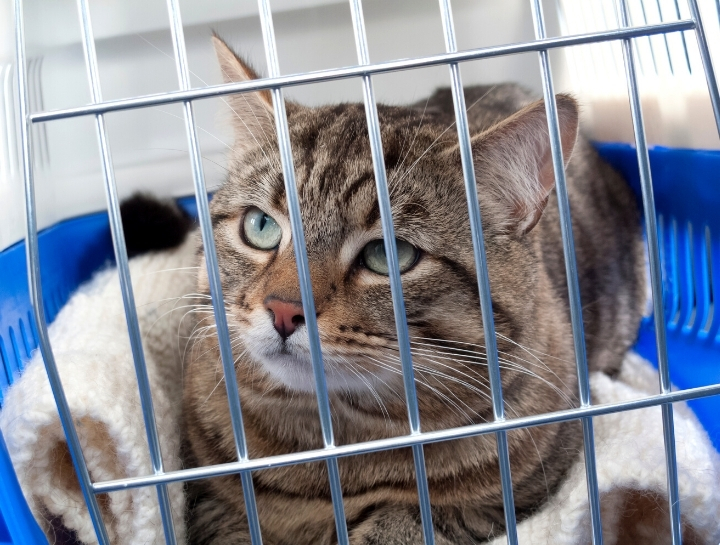Bringing Your Cat to the Vet

While there are more pet cats than dogs, most veterinarians tend to see more dogs than cats each year. When asked why they do not bring their cat to the veterinarian, most owners say that they believe their cat can take care of itself or that the visit is too stressful.
Unfortunately, this means that many cats do not receive the care they need. Regular exams are important for our feline friends, especially as they get older. Because cats are very adept at hiding signs of illness, we often do not notice anything is wrong until the disease process is fairly advanced.
Below are a few tips on how to make your cat's visit to the veterinarian less stressful.
- Cats don't like change and, unfortunately, coming to the vet is a big change. In addition, most cats only see the pet carrier right before they come for a visit, making the sight of the carrier a stressful event in itself. The easiest way to decrease carrier stress is to leave the carrier out either all the time or start leaving it out a couple of weeks prior to a vet visit. You can try associating the pet carrier with happier things by either feeding near the carrier or leaving treats in the carrier. If you see your pet voluntarily enter the carrier, give it a treat. At first you may not see your cat entering the carrier and the treats or food will only disappear at night.
- What type of carrier works bests? While there is no one right answer, we recommend the hard pet carriers, which open on the top. This allows easier access for everyone, and, if necessary, the veterinarian can open the top of the carrier to perform most of the exam. When placing your cat in the carrier, add a piece of bedding that carries the smell of home. Another thing to try is wiping down the carrier with a calming pheromone, like Feliway, about an hour prior to placing your pet inside.
- The next challenge is getting your cat into the carrier. Hopefully by this point your pet is familiar enough with the carrier to enter voluntarily. If this happens, give your cat a treat once it is in the carrier. If your cat doesn't want to enter the carrier on its own, try bribing your pet with a favorite treat.
If your pet still won't enter the carrier, try one of the following:
- Place the carrier in a small room and then bring your cat into the room. You can still try to entice them into the carrier with treats or toys first.
- Pick up your cat and gently place it in the carrier. Depending on the type of pet carrier, this process can be easier or more difficult. With top opening carriers, simply open the top and make sure the side door is closed before putting your cat in the carrier.
- In carriers that can be taken apart so the top can be removed, place your cat in the bottom of the carrier before replacing the top. Just make sure to put the door opening towards a wall when doing this so the cat does not run out of the opening when you replace the top.
- Place your pet in the carrier hindquarters first. This way your cat cannot see the carrier coming and will be less stressed as you place it in there.
- Place the carrier in a small room and then bring your cat into the room. You can still try to entice them into the carrier with treats or toys first.
- In the car, make sure the carrier is secure. Some cats will like to look out a window, while others will prefer to be covered by a blanket. It is always best to keep them confined to the carrier while driving.
- When at the vet's office, if there is waiting area separate from dogs, place the carrier on a bench or table in this area. By putting the carrier up a little higher, the cat will feel more secure and be able to see what is happening around them. If your veterinarian does not offer a separate waiting area for cats, try to find a spot as far from dogs or other cats that you can.
- Most veterinarians try to get their feline patients into an exam room as soon as possible to help minimize the stress of the waiting area on your cat. Once in the exam room with the doors closed, place the carrier on the floor and open the carrier door. This will allow your cat to look around and come out if it wants. Your pet is more likely to leave the carrier on its own if you place the carrier on the floor rather than the table. It is then best to let your cat acclimate to the room a little, whether by letting your pet sit calmly in the carrier or by wandering about the room. If your cat has not left the carrier by the time the veterinarian enters the room for the exam, your vet may remove the top of the carrier and perform the exam while your cat is in the bottom half of the carrier. This allows the cat to feel slightly more secure in the strange new environment.
- Once the appointment is over, most cats will willing enter their carrier to go home. Cats are very sensitive to smell and the carrier smells like home. If you have other cats at home, be careful when reintroducing the cat that has gone to the veterinarian's office. The new smells of the vet's office may cause the cats to fight upon returning home. If this happens, try keeping the returning cat in a separate room for either a couple of hours or a day. This will allow the smells of home to be re-associated with the returning cat and the other cats will be more likely to accept him/her without a fight. Spraying a calming pheromone in the house (not on the cat) may also help with this.
These are just a few tips to help make your cat's visit to the veterinarian more pleasant. Unfortunately, we cannot totally eliminate the stress of an office visit, but we can try to minimize it by employing the above techniques.
Dr. Jennifer Ivankovig ("Dr. Jenny") is an associate at Animal House of Chicago. A graduate of Purdue University College of Veterinary Medicine, Dr. Jenny has a special interest in feline medicine as well as exotics (small mammals and birds).
